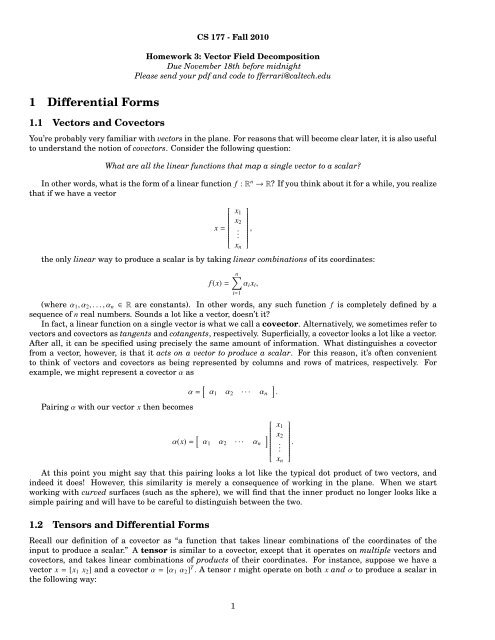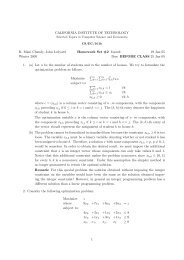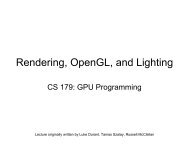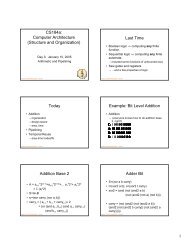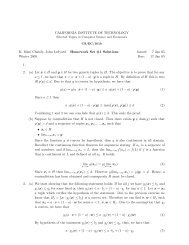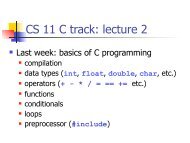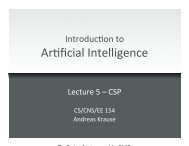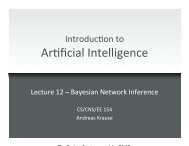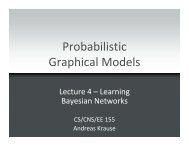1 Differential Forms - Caltech
1 Differential Forms - Caltech
1 Differential Forms - Caltech
You also want an ePaper? Increase the reach of your titles
YUMPU automatically turns print PDFs into web optimized ePapers that Google loves.
CS 177 - Fall 2010<br />
Homework 3: Vector Field Decomposition<br />
Due November 18th before midnight<br />
Please send your pdf and code to fferrari@caltech.edu<br />
1 <strong>Differential</strong> <strong>Forms</strong><br />
1.1 Vectors and Covectors<br />
You’re probably very familiar with vectors in the plane. For reasons that will become clear later, it is also useful<br />
to understand the notion of covectors. Consider the following question:<br />
What are all the linear functions that map a single vector to a scalar?<br />
In other words, what is the form of a linear function f : R n → R? If you think about it for a while, you realize<br />
that if we have a vector<br />
⎡<br />
x =<br />
⎢⎣<br />
the only linear way to produce a scalar is by taking linear combinations of its coordinates:<br />
n∑<br />
f (x) = α i x i ,<br />
x 1<br />
x 2<br />
.<br />
x n<br />
i=1<br />
(where α 1 , α 2 , . . . , α n ∈ R are constants). In other words, any such function f is completely defined by a<br />
sequence of n real numbers. Sounds a lot like a vector, doesn’t it?<br />
In fact, a linear function on a single vector is what we call a covector. Alternatively, we sometimes refer to<br />
vectors and covectors as tangents and cotangents, respectively. Superficially, a covector looks a lot like a vector.<br />
After all, it can be specified using precisely the same amount of information. What distinguishes a covector<br />
from a vector, however, is that it acts on a vector to produce a scalar. For this reason, it’s often convenient<br />
to think of vectors and covectors as being represented by columns and rows of matrices, respectively. For<br />
example, we might represent a covector α as<br />
Pairing α with our vector x then becomes<br />
,<br />
⎤⎥⎦<br />
α = [ α 1 α 2 · · · α n<br />
]<br />
.<br />
α(x) = [ α 1 α 2 · · · α n<br />
]<br />
At this point you might say that this pairing looks a lot like the typical dot product of two vectors, and<br />
indeed it does! However, this similarity is merely a consequence of working in the plane. When we start<br />
working with curved surfaces (such as the sphere), we will find that the inner product no longer looks like a<br />
simple pairing and will have to be careful to distinguish between the two.<br />
1.2 Tensors and <strong>Differential</strong> <strong>Forms</strong><br />
Recall our definition of a covector as “a function that takes linear combinations of the coordinates of the<br />
input to produce a scalar.” A tensor is similar to a covector, except that it operates on multiple vectors and<br />
covectors, and takes linear combinations of products of their coordinates. For instance, suppose we have a<br />
vector x = [x 1 x 2 ] and a covector α = [α 1 α 2 ] T . A tensor t might operate on both x and α to produce a scalar in<br />
the following way:<br />
⎡<br />
⎢⎣<br />
x 1<br />
x 2<br />
.<br />
x n<br />
.<br />
⎤⎥⎦<br />
1
t(x, α) = 3x 1 α 1 − x 1 α 2 + 4x 2 α 2 .<br />
In this case, we can also express t using matrix notation:<br />
t(x, α) = [ α 1 α 2<br />
] [ 3 0<br />
−1 4<br />
] [ ]<br />
x1<br />
.<br />
x 2<br />
In general, however, a tensor may map many vectors and covectors to a scalar – not just one of each – so we<br />
cannot always express it as a matrix operation. If a tensor maps k vectors and l covectors to a scalar, we call it<br />
a “k-times covariant, l-times contravariant” tensor.<br />
Finally, a differential form or differential k-form is a k-times covariant antisymmetric tensor. In other<br />
words, it’s an object that eats k vectors and spits out a scalar (in a linear way!), and whose sign changes if we<br />
swap any pair of arguments. For instance, if α is a 3-form and u, v, and w are vectors, then<br />
α(u, v, w) = −α(w, v, u),<br />
etc. Note that a differential 1-form is the same thing as a covector! <strong>Differential</strong> forms play an important<br />
role in geometry and physics, and are often used to represent physical quantities as we’ll see in some of our<br />
applications. Finally, it is important to note that while most authors make a linguistic distinction between a<br />
“vector” and a “vector field,” many do not make the distinction between a “differential form” and a “differential<br />
form field” – the former is simply used interchangeably.<br />
2 Exterior Calculus<br />
You’re probably familiar with vector calculus which consists of operations on “primal” objects such as vector<br />
fields. It is also possible to define an exterior calculus that consists of operations on “dual” objects such<br />
as covectors and differential forms. The duality between the two makes it possible to define any differential<br />
operator from vector calculus using the language of exterior calculus. One reason why this approach is nice<br />
from a practical point of view is that exterior calculus has only a single differential operator, called the exterior<br />
derivative, which is denoted d. In the discrete setting, this means that only one differential operator ever has<br />
to be defined and implemented. Here are a few typical differential operators from vector calculus expressed<br />
using the exterior derivative 1 ∇ f = d f<br />
∇ × F = ⋆dF<br />
∇ · F = ⋆d ⋆ F<br />
The additional map ⋆ is called the Hodge star and introduces another kind of duality within exterior calculus<br />
– we will discuss the Hodge star in more detail later. It is also important to note that covector fields are a<br />
special case of something called a differential form. In particular, covector fields are referred to as 1-forms and<br />
“look” much like vector fields. Another common special case is the 0-form, which can be thought of as a scalar<br />
field. You will often see differential forms written in coordinate notation where the magnitude is given for each<br />
principal direction. For example, a 1-form α = dx − ydz basically looks like a vector field whose magnitude is<br />
1 in the x-direction, 0 in the y-direction, and −y in the z-direction. Much like the gradient operator maps a<br />
scalar field to a vector field, the exterior derivative will map a 0-form to a 1-form. More generally, the exterior<br />
derivative maps a k-form to a (k + 1)-form. Finally, the exterior derivative has the important property that<br />
d ◦ d = 0.<br />
2.1 Discrete Exterior Calculus<br />
In order to actually compute with exterior calculus, we need to define a discrete exterior calculus (DEC) that<br />
operates on quantities defined over some discrete differential geometry. In particular, we will define discrete<br />
differential forms as quantities stored on simplicial meshes 2 , and discrete differential operators that act on<br />
these forms in a way that faithfully mirrors the behavior of the smooth operators.<br />
1 Technically speaking these operators are not identical since the operators from vector calculus operate on the tangent bundle whereas<br />
the operators from exterior calculus operate on the cotangent bundle. Since these two spaces are dual, however, there exists a pair of very<br />
simple operators ♯ (sharp) and ♭ (flat) which can be used to convert an object from vector calculus to exterior calculus and then back again.<br />
For instance, we should really write ∇ × F = [ ⋆ ( dF ♭)] ♯ if we want the two operations to be truly identical maps.<br />
2 Most operations in DEC are well-defined for more general cell complexes, but we will stick to simplicial complexes for simplicity.<br />
2
2.2 Discrete <strong>Differential</strong> <strong>Forms</strong><br />
Discrete differential forms actually have a very simple representation: a k-form is represented by a single<br />
scalar quantity at each k-dimensional simplex of the mesh. So for instance, a 0-form stores a scalar value at<br />
each vertex, a 1-form stores a scalar value at each edge, etc. For 0-forms, you should think of this scalar as<br />
simply a point sample of a scalar-valued function. For 1-forms, you should think of this scalar as the total<br />
circulation along that edge. In other words, if you think of a smooth covector field as passing over an edge,<br />
then the scalar will tell you how much total “stuff” is moving parallel to that edge. In general, you can think<br />
of a discrete k-form as the integral of the evaluation of a smooth k-form over each k-simplex.<br />
In addition to knowing how much stuff is moving through each simplex, we also need to know in which<br />
direction the stuff is moving. In other words, if we have an edge between vertices a and b, we need to know<br />
whether the stuff is flowing from a to b or from b to a. Hence, we give each edge an orientation (either a to<br />
b or b to a) that gives us a canonical direction along which stuff flows. Then a positive scalar on this edge<br />
indicates that stuff is flowing in the canonical direction, and a negative scalar indicates that stuff is flowing in<br />
the opposite direction. It doesn’t matter how we pick this orientation as long as we are consistent.<br />
2.2.1 Discretizing Smooth <strong>Forms</strong><br />
Quite often, integration of a smooth form over a simplex is done via numerical quadrature. Numerical quadrature<br />
picks a collection of quadrature points x i and corresponding quadrature weights w i , and approximates an<br />
integral using a weighted sum of function values at the quadrature points. For example, the integral of a<br />
function f over a domain Ω would be approximated as<br />
∫<br />
∑<br />
f (x)dx ≈ V(Ω) w i f (x i )<br />
Ω<br />
where V(Ω) is the volume of Ω.<br />
For functions defined over simplices, there are a number of possible choices for weights and quadrature<br />
points – the choice of which quadrature to use depends on the desired accuracy and the degree of the function<br />
being integrated. For instance, one-point Gaussian quadrature on a simplex places a single quadrature point<br />
of weight one at the barycenter of the simplex; for a linear function f , this choice of quadrature will in fact give<br />
the exact answer.<br />
Exercise 1. Given the oriented simplicial complex depicted below and the smooth 1-form ω = 2xdy − ydx,<br />
compute the corresponding discrete 1-form (i.e., give the value stored on each edge).<br />
i<br />
(0,1)<br />
(1,1)<br />
e 1<br />
e 2<br />
e 3<br />
e 5<br />
e 4<br />
(0,0) (1,0)<br />
Coding 1. Starting with the template below, write a MATLAB routine that discretizes the smooth 1-form<br />
ω(x, y) = 2e −(x2 +y 2) ((x + y)dx + (y − x)dy) .<br />
Approximate the integral over each edge with a single quadrature point located at the edge midpoint.<br />
You can test whether your routine is working properly by temporarily replacing ω with the linear 1-form<br />
ω = 2xdy − ydx and running it on the mesh file test.obj, which corresponds to the discretization perfomed in<br />
the previous exercise.<br />
3
function omega = discretize_oneform( V, E )<br />
% function omega = discretize_oneform( V, E )<br />
%<br />
% INPUT:<br />
% V - dense 2x|V| matrix of vertex positions<br />
% E - dense |E|x2 matrix of edges as 1-based indices into vertex list<br />
%<br />
% OUTPUT:<br />
% omega - |E|x1 vector of discrete 1-form values stored on edges<br />
%<br />
2.2.2 Interpolating Discrete <strong>Forms</strong><br />
1<br />
v<br />
0<br />
0<br />
Although we can generally perform all of our computations directly using discrete differential forms, it is<br />
sometimes necessary to construct a smooth form corresponding to a discrete form. One way to construct such<br />
a form is via interpolation. The Whitney forms or Whitney bases provide a set of smooth forms that interpolate<br />
discrete forms defined on a simplicial complex.<br />
The Whitney 0-forms are basis elements for forms defined on vertices, and are denoted φ i where i is the<br />
vertex of interest. In fact, φ i is simply the hat function on vertex i, i.e., the unique function that equals one at<br />
vertex i, zero at all other vertices, and is affine over each 2-simplex (see illustration above, left).<br />
Whitney 1-forms interpolate values stored on edges, and are denoted φ i j where the edge of interest is oriented<br />
away from vertex i and toward vertex j. The 1-form bases can be expressed in terms of the 0-form<br />
bases:<br />
φ i j = φ i dφ j − φ j dφ i<br />
where d is the (smooth) exterior derivative on 0-forms – see the next section for details. Notice that the<br />
orientation of the edge (i to j vs. j to i) does matter here since φ i j is antisymmetric with respect to i and j,<br />
i.e., φ i j = −φ ji . An illustration of a discrete 1-form on a triangle interpolated using the Whitney 1-form basis is<br />
shown above (right). Edge labels indicate the value of the discrete form on each edge and arrows indicate the<br />
direction and magnitude of the interpolated field.<br />
The Whitney 2-forms interpolate values stored on faces, and are denoted φ i jk where the face of interest<br />
contains vertices i, j, and k. The 2-form bases are simply piecewise constant functions that equal 1/A inside<br />
the face (i, j, k) and zero elsewhere, where A is the area of the face.<br />
(Note: you may wish to read the section on the exterior derivative before continuing with the following<br />
exercises.)<br />
4
Exercise 2. The barycentric coordinates for a point p in a simplex σ give, roughly speaking, the proximity of<br />
p to each of the vertices of σ. More specifically, the ith barycentric coordinate function λ i : |σ| → R is the unique<br />
affine function that equals one at vertex i and zero at all other vertices. In other words, λ i (v j ) = δ i j (where δ is<br />
the Kronecker delta). Make a (simple!) argument that on a 2-simplex, λ i (p) is the same as the ratio<br />
f (p) =<br />
〈p, j, k〉<br />
〈i, j, k〉<br />
where j and k are the indices of the other two vertices in the 2-simplex and 〈i, j, k〉 denotes the area of the<br />
triangle with vertices v i , v j , and v k .<br />
v i<br />
p<br />
v j<br />
v k<br />
(Hint: think about the gradient of the area of a triangle. In the remaining exercises, you may find it convenient<br />
to denote the rotation in the plane of a vector v by an angle π/2 by v ⊥ .)<br />
Exercise 3. Derive an expression for Whitney 1-form bases on a simplicial 2-complex that is suitable for<br />
implementation. In particular, for a 2-simplex σ with vertices v i , v j , and v k , give an expression for φ i j (p) purely<br />
in terms of triangle areas and edge vectors, where p is any point inside the simplex.<br />
(Hint: the Whitney 0-form bases restricted to a single simplex are merely the barycentric coordinate functions<br />
for that simplex.)<br />
Exercise 4.<br />
Let e 1 , e 2 , and e 3 be the three edge vectors of a triangle oriented as in the figure below. Show that<br />
(This fact will be useful in the next exercise.)<br />
e ⊥ 2 + e⊥ 3 = −e⊥ 1 .<br />
e 1<br />
e 2<br />
e 3<br />
e 1<br />
e 2<br />
e 3<br />
Exercise 5. One nice property of Whitney forms is that interpolating with Whitney forms and then applying<br />
the (smooth) exterior derivative is the same as applying the (discrete) exterior derivative and then interpolating<br />
with Whitney forms. In other words, the following diagram commutes:<br />
5
ˆω k<br />
ˆd k<br />
−−−−−→ ˆω k+1<br />
φ k ⏐↓<br />
⏐↓φ k+1<br />
ω k d k<br />
−−−−−→ ω k+1<br />
where ˆω k is a discrete k-form and ω k is a smooth k-form. Consider a simplicial 2-complex K and prove that<br />
this relationship holds in the case of k = 0, i.e., show that<br />
for any discrete 0-form ω on K.<br />
φ 1 ˆd 0 ˆω = d 0 φ 0 ˆω<br />
(Hint: consider a single 2-simplex; the results of the previous three exercises will be useful.)<br />
Coding 2. Write a MATLAB routine that interpolates a discrete 1-form over a single 2-simplex in the plane<br />
using the Whitney 1-form bases, starting with the template below. (In other words, implement the expression<br />
derived in Exercise 3.) This routine will be used to display the vector field decomposition produced in a later<br />
exercise. You may find it useful to use the subroutine A = triangle area( a, b, c ). Additionally, you<br />
should test your routine by running the script draw whitney oneform.m. This script produces an output file<br />
oneform.ps which displays the Whitney 1-form basis for a single edge in a triangle and should match the<br />
appearance of the illustration above. Please include a printout of this output with your written assignment.<br />
function u = oneform( V, omega, p )<br />
% function u = oneform( V, omega, p )<br />
%<br />
% Interpolates a discrete 1-form using the Whitney basis.<br />
%<br />
% INPUT:<br />
% V - 2x3 matrix; columns give vertex coordinates of vertices in triangle {a,b,c}<br />
% omega - 3x1 vector of 1-form values stored on edges (a,b), (b,c), (c,a), resp.<br />
% p - 2x1 vector representing sample location<br />
%<br />
% OUTPUT:<br />
% u - 2x1 vector giving interpolated 1-form at p<br />
%<br />
2.3 Discrete Exterior Derivative<br />
Recall that the smooth exterior derivative d maps a k-form to a (k + 1)-form. In our discrete framework, this<br />
means we want an operator that maps a scalar quantity stored on k-dimensional simplices to a scalar quantity<br />
on (k + 1)-dimensional simplices. The discrete version of the exterior derivative turns out to be a very simple<br />
procedure: to get the scalar value for a particular (k + 1)-simplex, we basically just add up the values stored on<br />
all the k-simplices along its boundary! With one caveat: we need to be careful about orientation. Since the sign<br />
of the scalar value changes depending on the orientation of each simplex (and since this choice is arbitrary),<br />
we need to take orientation into account in our sum. In general this means that if the orientation of a simplex<br />
and one of the simplices on its boundary are opposite, we subtract the value stored on the boundary simplex<br />
from our sum; otherwise, we add this value.<br />
For instance, in the special case of a 0-form (i.e., a scalar function on vertices), the exterior derivative is<br />
incredibly simple to compute: to get the scalar value for an edge whose orientation is from a to b, simply<br />
subtract the value at a from the value at b!<br />
Exercise 6. Let α be the discrete 1-form on the mesh pictured below given by the following table:<br />
e 1 2<br />
e 2 -1<br />
e 3 3<br />
e 4 -4<br />
e 5 7<br />
6
Compute the discrete 2-form dα, paying careful attention to orientation.<br />
Exercise 7. The discrete exterior derivative on k-forms can be represented by a matrix d k ∈ R m×n where n is<br />
the number of k-simplices in the complex, m is the number of (k + 1)-simplices. Entry (i, j) of d k equals ±1 if the<br />
ith (k + 1)-simplex contains the jth k-simplex, where the sign is positive if the orientations of the two simplices<br />
agree and negative otherwise. (All other entries in the matrix are zero.) Compute the matrix representations<br />
for d 0 and d 1 on the mesh pictured below, and verify that d 1 d 0 = 0.<br />
v 4<br />
v 3<br />
f 1<br />
f 2<br />
e 1<br />
e 2<br />
e 3<br />
e 4<br />
v 1<br />
e 5<br />
v 2<br />
Coding 3. Write a MATLAB routine that builds (sparse!) matrices representing the discrete exterior derivatives<br />
on 0- and 1-forms, starting with the template below. Edges should be oriented such that each edge points<br />
from the smaller to the larger index. Faces should be oriented according to the input. The input to this routine<br />
is slightly different than in the previous assignment: rather than a pair (V, F) where each row of F is a list<br />
of vertex indices for a face, the routine accepts a triple (V, E, F) where each row of E gives a pair of vertex<br />
indices defining an edge and each row of F gives a triple of edge indices defining a face. Additionally, the sign<br />
of edge indices indicates whether they agree (positive) or disagree (negative) with the orientation of that face.<br />
The routine [V,E,F] = read mesh( filename ) (provided) produces data in this format from a Wavefront<br />
OBJ mesh. You can test your code by running it on the mesh test.obj – this mesh corresponds to the one<br />
used in the previous exercise 3 You should also test that repeated application of the exterior derivative equals<br />
zero, i.e., that d1*d0 yields a matrix of all zeros in MATLAB.<br />
function [d0,d1] = build_exterior_derivatives( V, E, F )<br />
% function [d0,d1] = build_exterior_derivatives( V, E, F )<br />
%<br />
% INPUT:<br />
% V - dense 2x|V| matrix of vertex positions<br />
% E - dense |E|x2 matrix of edges as 1-based indices into vertex list<br />
% F - dense |F|x3 matrix of faces as 1-based indices into edge list<br />
%<br />
% OUTPUT:<br />
% d0 - sparse |E|x|V| matrix representing discrete exterior derivative on 0-simplices<br />
% d1 - sparse |F|x|E| matrix representing discrete exterior derivative on 1-simplices<br />
%<br />
2.3.1 Mesh Traversal<br />
Because the matrices d 0 and d 1 contain indicence information, they can also be used to traverse the mesh. In<br />
MATLAB, these matrices can be used in conjunction with the commands find and unique to iterate over<br />
mesh elements in a number of ways. For instance, suppose we wish to visit each face in the mesh and grab the<br />
indices of its three vertices. We might write something like this:<br />
3 Be warned, however, that depending on how you write your code, edge indices might not match those in the figure! Hence d0 and d1<br />
might have rows and columns (respectively) swapped relative to your answer for the previous exercise.<br />
7
nFaces = size( d1, 1 );<br />
for i = 1:nFaces<br />
end<br />
% initialize an empty list of vertex indices<br />
ind = [];<br />
for j = find( d1( i, : )) % iterate over this face’s edges<br />
for k = find( d0( j, : )) % iterate over this edge’s vertices<br />
end<br />
end<br />
% append the current vertex index to the list<br />
ind = [ ind, k ];<br />
% eliminate redundant vertex indices from the list<br />
I = unique( I );<br />
The find command returns a list of the indices of all non-zero entries in a given vector. So for instance,<br />
since the ith row of d 1 corresponds to the ith face in the mesh, we can run find on this row to get the indices<br />
of all the incident edges. The unique command removes any element of a list that appears more than once.<br />
In our example above every vertex is found in two edges of a given face, so we remove redundant indices with<br />
unique. This type of mesh traversal will be useful in later coding exercises.<br />
2.3.2 Smooth Exterior Derivative on 0-forms<br />
For some of the above exercises it will be necessary to compute the exterior derivative of smooth 0-forms in<br />
coordinates. Such a computation is actually quite simple: for instance, given a (smooth) 0-form f : R 2 → R, its<br />
exterior derivative is given by<br />
d f = ∂ f<br />
∂x dx + ∂ f<br />
∂y dy.<br />
The forms dx and dy can be thought of as standard bases for the (dual) plane. [ It is therefore ] sometimes<br />
∂ f /∂x<br />
convenient to think of d f as being merely the transpose of the column vector ∇ f = . Also note that d<br />
∂ f /∂y<br />
is a linear operator since ∂ ∂x and ∂ ∂y<br />
are both linear operators.<br />
Exercise 8. Compute (in coordinates) the smooth exterior derivative of the 0-form α : R 3 → R given by<br />
α = y cos z + 4 sin x.<br />
8
2.4 Hodge Star<br />
2.4.1 Circumcentric Dual<br />
primal<br />
dual<br />
In addition to the typical mesh used to discretize our geometry, many operations in DEC require that we<br />
define a dual mesh or dual complex. In general, the dual of an n-dimensional simplicial complex identifies<br />
every k-simplex in the primal (i.e., original) complex with a unique (n − k)-cell in the dual complex. In a twodimensional<br />
simplicial complex, for instance, primal vertices are identified with dual faces, primal edges are<br />
identified with dual edges, and primal faces are identified with dual vertices. Note that the dual cells are not<br />
always simplices! However, they can be described as a collection of simplices. (See illustrations above.)<br />
The combinatorial relationship between the two meshes is often not sufficient, however. We may also need<br />
to know where the vertices of our dual mesh are located. In the case of a simplicial n-complex embedded in R n ,<br />
dual vertices are often placed at the circumcenter of the corresponding primal simplex. The circumcenter of a<br />
k-simplex is the center of the unique (k − 1)-sphere containing all of its vertices; equivalently, it is the unique<br />
point equidistant from all vertices of the simplex (this latter definition is perhaps more useful in the case of a<br />
0-simplex). This particular dual is known as the circumcentric dual. The following exercises prove a statement<br />
which can be useful when constructing the circumcentric dual of a given mesh.<br />
Exercise 9. Show that the circumcenter of a triangle is the intersection of the perpendicular bisectors of its<br />
edges.<br />
(Hint: use the symmetry of isosceles triangles.)<br />
Exercise 10. Consider the lines passing through the circumcenters of the faces of a tetrahedron, each one<br />
perpendicular to its associated face. Show that the circumcenter of the tetrahedron is the intersection of these<br />
9
four lines. Generalize your proof to show that the circumcenter of a k-simplex is the intersection of the k + 1<br />
orthogonal lines through the circumcenters of its faces.<br />
Coding 4. Write a MATLAB routine that computes the circumcenters of all 0-, 1-, and 2-simplices in a given<br />
simplicial 2-complex, starting with the template below. Note that the complex is embedded in R 2 , hence each<br />
column of V gives the coordinate of a vertex. Once you have computed the circumcenters, call the routine<br />
write circumcentric subdivision( filename, d0, d1, c0, c1, c2 ) to verify your results. This<br />
routine will produce a PostScript drawing of the circumcentric subdivision of the original simplicial complex –<br />
please turn a printout of this file in with your written exercises.<br />
function [c0,c1,c2] = compute_circumcenters( V, d0, d1 )<br />
% function [c0,c1,c2] = compute_circumcenters( V, d0, d1 )<br />
%<br />
% INPUT:<br />
% V - dense 2x|V| matrix of vertex positions<br />
% d0 - sparse |E|x|V| matrix representing discrete exterior derivative on 0-simplices<br />
% d1 - sparse |F|x|E| matrix representing discrete exterior derivative on 1-simplices<br />
%<br />
% OUTPUT:<br />
% c0 - dense 2x|V| matrix of vertex circumcenters<br />
% c1 - dense 2x|E| matrix of edge circumcenters<br />
% c2 - dense 2x|F| matrix of face circumcenters<br />
2.4.2 Discrete Hodge Star<br />
primal 1-form (circulation)<br />
dual 1-form (flux)<br />
In (smooth) exterior calculus, the Hodge star identifies a k-form with a particular (n k)-form (called its<br />
Hodge dual), and represents a duality somewhat like the duality between vectors and 1-forms. We can of<br />
10
course define an analogous duality in discrete exterior calculus: the discrete Hodge dual of a (discrete) k-form<br />
on the primal mesh is an (n − k)-form on the dual mesh. Similarly, the Hodge dual of an k-form on the dual<br />
mesh is a k-form on the primal mesh. Discrete forms on the primal mesh are called primal forms and discrete<br />
forms on the dual mesh are called dual forms. Given a discrete form α (whether primal or dual), its Hodge<br />
star is typically written as ⋆α. The star is sometimes used to denote a dual cell as well. For instance, if σ is a<br />
simplex in a primal complex, ⋆σ is the corresponding cell in the dual complex.<br />
Unlike smooth forms, discrete primal and dual forms live in different spaces (so for instance, discrete primal<br />
k-forms and dual k-forms cannot be added to each other). In fact, primal and dual forms often have different<br />
(but related) physical interpretations. For instance, a primal 1-form might represent the total circulation along<br />
edges of the primal mesh, whereas in the same context a dual 1-form might represent the total flux through<br />
the corresponding dual edges (see illustration above). Of course, these two quantities are related, and it leads<br />
one to ask, “precisely how should the Hodge star be defined?”<br />
It turns out that there are several ways to define the discrete Hodge star, but most common is the diagonal<br />
Hodge star, which we will use throughout the rest of this assignment. Consider a primal k-form α defined on<br />
a complex K and let K ′ be the corresponding dual complex. If α i is the value of α on the k-simplex σ i , then the<br />
diagonal Hodge star is defined by<br />
⋆α i = | ⋆ σ i|<br />
α i<br />
|σ i |<br />
for all i, where |σ| indicates the volume of σ (note that if σ is a 0-cell then |σ| = 1) and ⋆σ ∈ K ′ . In<br />
other words, to compute the dual form we simply multiply the scalar value stored on each cell by the ratio of<br />
corresponding dual and primal volumes.<br />
If we remember that a discrete form can be thought of as a smooth form integrated over each cell, this<br />
definition for the Hodge star makes perfect sense: the primal and dual quantities should have the same<br />
density, but we need to account for the fact that they are integrated over cells of different volume. We therefore<br />
normalize by a ratio of volumes when mapping between primal and dual. This particular Hodge star is called<br />
diagonal since the ith element of the dual form depends only on the ith element of the primal form. Hence<br />
the Hodge star can be implemented as multiplication by a diagonal matrix whose entries are simply the ratios<br />
described above. Clearly, then, the Hodge star that takes dual forms to primal forms (the dual Hodge star) is<br />
the inverse of the one that takes primal to dual forms (the primal Hodge star).<br />
Coding 5. Write a MATLAB routine that builds (sparse!) diagonal matrices representing the diagonal Hodge<br />
star operators on 0- 1- and 2-forms, starting with the template below. You may find it useful to use the<br />
subroutine A = triangle area( a, b, c ).<br />
function [star0,star1,star2] = build_hodge_stars( d0, d1, c0, c1, c2 )<br />
% function [star0,star1,star2] = build_hodge_stars( d0, d1, c0, c1, c2 )<br />
%<br />
% INPUT:<br />
% d0 - sparse |E|x|V| matrix representing discrete exterior derivative on 0-simplices<br />
% d1 - sparse |F|x|E| matrix representing discrete exterior derivative on 1-simplices<br />
% c0 - dense 2x|V| matrix of vertex circumcenters<br />
% c1 - dense 2x|E| matrix of edge circumcenters<br />
% c2 - dense 2x|F| matrix of face circumcenters<br />
%<br />
% OUTPUT:<br />
% star0 - sparse diagonal |V|x|V| matrix representing Hodge star on primal 0-forms<br />
% star1 - sparse diagonal |E|x|E| matrix representing Hodge star on primal 1-forms<br />
% star2 - sparse diagonal |F|x|F| matrix representing Hodge star on primal 2-forms<br />
%<br />
11
3 Hodge Decomposition<br />
3.1 Decomposition of Vector Fields<br />
= +<br />
+<br />
vector field<br />
curl-free<br />
divergence-free<br />
(harmonic=0)<br />
The Hodge decomposition theorem states that any vector field X : R 3 → R 3 with compact support can be<br />
written as a unique sum of a divergence-free component ∇ f , a curl-free component ∇ × A, and a harmonic part<br />
H:<br />
X = ∇ f + ∇ × A + H. (1)<br />
Here f is called a scalar potential and A is called a vector potential. H is a harmonic vector field, i.e., a<br />
vector field such that both ∇ · H = 0 and ∇ × H = 0. Intuitively, ∇ f accounts for sources and sinks in X, ∇ × A<br />
accounts for vortices, and H accounts for any constant motion. The Hodge decomposition theorem also applies<br />
to two-dimensional vector fields X : R 2 → R 2 , but in this case A is a scalar field which can be thought of as the<br />
signed magnitude of a vector potential sticking out of the plane. The image above gives an example of Hodge<br />
decomposition for a vector field with a zero harmonic component.<br />
Using a little bit of knowledge about vector calculus, we can come up with a simple procedure for actually<br />
finding the Hodge decomposition of a vector field. First, recall that ∇ × ∇ f = 0 and that ∇ · ∇ × A = 0. In<br />
other words, the curl of a curl-free field is zero, and the divergence of a divergence-free field is also zero! Also<br />
remember that both the curl and the divergence of a harmonic vector field are identically zero. Then taking<br />
the divergence of equation (1) gives us<br />
∇ · X = ∇ · ∇ f + ∇ · ∇ × A + ∇ · H<br />
= ∇ 2 f + 0 + 0<br />
= ∇ 2 f<br />
(2)<br />
where ∇ 2 = ∇ · ∇ is the Laplacian operator. Similarly, taking the curl of equation 1 gives us<br />
∇ × X = ∇ × ∇ f + ∇ × ∇ × A + ∇ × H<br />
= 0 + ∇ × ∇ × A + 0<br />
= ∇ × ∇ × A.<br />
We can solve equations (2) and (3) for the potentials f and A, and then use these two quantities to compute<br />
the harmonic part<br />
3.2 Decomposition of <strong>Forms</strong><br />
H = X − ∇ f − ∇ × A. (4)<br />
Of course, since vector calculus and exterior calculus are dual, we can translate this procedure into the language<br />
of exterior calculus. By doing so, we will be able to easily compute the Hodge decomposition of a vector<br />
field using our existing DEC framework.<br />
Exercise 11. Using the identities from section 2, rewrite the Hodge decomposition theorem in the language<br />
of exterior calculus, where ω is any 1-form, α is a 0-form representing the scalar potential, β is a 2-form<br />
representing the vector potential, and γ is a harmonic form. Similar to a harmonic vector field, a harmonic<br />
(3)<br />
12
form is any form γ such that ⋆d ⋆ γ = 0 and ⋆dγ = 0 4 . Use this new version of the theorem to show that the<br />
following system of equations (analogous to the vector equations (2), (3), and (4) can be solved for the Hodge<br />
decomposition 5 :<br />
d ⋆ ω = d ⋆ dα (5)<br />
dω = d ⋆ d ⋆ β (6)<br />
γ = ω − dα − ⋆d ⋆ β (7)<br />
You may assume that ⋆ ⋆ ω = ω for any form ω, which is a valid assumption for forms defined on a threedimensional<br />
space.<br />
Coding 6. Write a MATLAB routine that computes the Hodge decomposition of a discrete 1-form in the plane,<br />
starting with the template below. For each instance of d and ⋆ in the system above, you should carefully<br />
consider which operator to use based on the degree of the form and whether the form is primal or dual. For<br />
instance, in the equation used to find the curl-free component, i.e.,<br />
d ⋆ ω = d ⋆ dα,<br />
the first d applied to f is the exterior derivative on primal 0-forms, the ⋆ to its left is then the Hodge star<br />
on primal 1-forms, and the final d is the exterior derivative on dual 1-forms. Note that the exterior derivative<br />
on dual k-forms is simply the transpose of the exterior derivative on primal (n − k − 1)-forms. Similarly, the<br />
Hodge star on dual k-forms is the inverse of the Hodge star on primal k-forms. (Think about why these two<br />
statements are true!) When writing these operators it can also be helpful to consider the dimensions of the<br />
matrices involved. Once you have computed the potentials α and β you will need to apply the appropriate<br />
differential operators to get the return values curlfree and divfree (whereas harmonic is simply equal to<br />
γ).<br />
function [curlfree,divfree,harmonic] = decompose_oneform(omega,d0,d1,star0,star1,star2)<br />
% function [curlfree,divfree,harmonic] = decompose_oneform(omega,d0,d1,star0,star1,star2)<br />
%<br />
% INPUT:<br />
% omega - |E|x1 vector representing input (discrete) 1-form stored on edges<br />
% d0 - sparse |E|x|V| matrix representing discrete exterior derivative on 0-simplices<br />
% d1 - sparse |F|x|E| matrix representing discrete exterior derivative on 1-simplices<br />
% star0 - sparse diagonal |V|x|V| matrix representing Hodge star on primal 0-forms<br />
% star1 - sparse diagonal |E|x|E| matrix representing Hodge star on primal 1-forms<br />
% star2 - sparse diagonal |F|x|F| matrix representing Hodge star on primal 2-forms<br />
%<br />
% OUTPUT:<br />
% curlfree - |E|x1 vector representing curl-free component of omega<br />
% divfree - |E|x1 vector representing divergence-free component of omega<br />
% harmonic - |E|x1 vector representing harmonic component of omega<br />
%<br />
Coding 7. Using several of the routines you have already written, run the following MATLAB script that<br />
discretizes a smooth 1-form, computes its Hodge decomposition, and visualizes the result as a collection<br />
of smooth 1-forms interpolated by the Whitney basis functions. (This script can also be found in the file<br />
hodge decomposition.m.) Run this script on the mesh disk.obj and the 1-form ω described in Coding 1.<br />
Print the output files input.ps, curlfree.ps, divfree.ps, and harmonic.ps.<br />
4 More typically, a harmonic form is defined as any form whose Laplacian vanishes, i.e., any form γ such that (⋆d ⋆ d + d ⋆ d⋆)γ = 0.<br />
However, these two definitions turn out to be equivalent. The implication one way is obvious, since both terms in the Laplacian vanish<br />
immediately. In the other direction, consider that the operators d and δ = ⋆d⋆ are adjoint and let 〈·, ·〉 denote the L 2 inner product on<br />
forms. Then by linearity we have 〈0, γ〉 = 〈(δd + dδ)γ, γ〉 = 〈δdγ, γ〉 + 〈dδγ, γ〉 = 〈δγ, δγ〉 + 〈dγ, dγ〉 = 0, which implies that both dγ and δγ equal<br />
zero since the L 2 norm is non-negative.<br />
5 Note that in three dimensions our system has a nontrivial null space - in particular, any solution of the form β + δκ = β ⋆ + ⋆ d ⋆ κ<br />
is valid for an arbitrary 3-form κ (equivalently, for any co-exact 2-form δκ). However, since we take the curl of this expression to find the<br />
divergence-free field, this component of the solution will vanish in our final decomposition, i.e., δ(β + δκ) = δβ + δδκ = δβ. In MATLAB, the<br />
backslash (\) operator should automatically use a direct solver for singular systems such as these, though in practice you may wish to<br />
augment your system so that you can take advantage of a more efficient solver.<br />
13
Recall that the 1-form ω used in discretize oneform is given by<br />
ω(x, y) = 2e −(x2 +y 2) ((x + y)dx + (y − x)dy) ,<br />
which is depicted at the beginning of this section 6 . The Hodge decomposition of ω can be expressed analytically<br />
as<br />
ω(x, y) = ∇g(x, y) + ∇ × g(x, y)<br />
where g = α = β serves as both the scalar and the vector potential, and is given by<br />
g(x, y) = −e x2 +y 2 .<br />
Hence, the potentials α and β should both look like a Gaussian “bump,” and the curl-free and divergencefree<br />
components ∇α and ∇ × β of ω should look like the source and vortex pictured at the beginning of this<br />
section.<br />
When debugging, you may find it useful to discretize ∇α and ∇ × β directly and compare with the 1-forms<br />
computed via Hodge decomposition. (At the very least, you should verify that your output files roughly match<br />
the appearance of the images above.) Additionally, three alternative definitions for omega are provided to help<br />
verify the correctness of your routines: a purely curl-free omega, a purely divergence-free omega, and a purely<br />
harmonic omega. For each of these cases Hodge decomposition should reproduce the input exactly in one of<br />
the three components (curlfree, divfree, or harmonic) while the other two components should vanish.<br />
(Simply uncomment the appropriate line to use one of these test cases.) Additionally, two meshes are provided<br />
for testing: disk.obj and annulus.obj. The harmonic part of the output should always be zero for the disk,<br />
and you should find a non-zero harmonic part for 1-forms over the annulus.<br />
stderr = 2;<br />
input_filename = ’../meshes/disk.obj’;<br />
fprintf( stderr, ’Reading...\n’ );<br />
[V,E,F] = read_mesh( input_filename );<br />
fprintf( stderr, ’Building exterior derivatives...\n’ );<br />
[d0,d1] = build_exterior_derivatives( V, E, F );<br />
fprintf( stderr, ’Computing circumcenters...\n’ );<br />
[c0,c1,c2] = compute_circumcenters( V, d0, d1 );<br />
fprintf( stderr, ’Writing circumcentric subdivision...\n’ );<br />
write_circumcentric_subdivision( ’subdivision.ps’, d0, d1, c0, c1, c2 );<br />
fprintf( stderr, ’Building Hodge stars...\n’ );<br />
[star0,star1,star2] = build_hodge_stars( d0, d1, c0, c1, c2 );<br />
fprintf( stderr, ’Discretizing smooth 1-form...\n’ );<br />
omega = discretize_oneform( V, E );<br />
% Some test cases:<br />
% omega = d0*rand(size(V,2),1); % curl-free test case<br />
% omega = (star1ˆ-1)*d1’*star2*rand(size(F,1),1); % divergence-free test case<br />
% omega = null( d0*(star0ˆ-1)*d0’*star1 + (star1ˆ-1)*d1’*star2*d1 ); % harmonic test case<br />
fprintf( stderr, ’Decomposing discrete 1-form...\n’ );<br />
[ curlfree, divfree, harmonic ] = decompose_oneform( omega, d0, d1, star0, star1, star2 );<br />
M = max( abs( omega ));<br />
6 Note that this 1-form does not have compact support, which was one of the requirements of the Hodge decomposition theorem!<br />
Numerically, however, the field decays fast enough that we can treat it as compact – in general certain boundary conditions are required<br />
to deal with non-compactness. For more details, see Tong et al, Discrete Multiscale Vector Field Decomposition, in the Proceedings of ACM<br />
SIGGRAPH 2003.<br />
14
fprintf( stderr, ’Interpolating input...\n’ );<br />
write_interpolated_vector_field( ’input.ps’, omega/M, d0, d1, c0, c1, c2 );<br />
fprintf( stderr, ’Interpolating curl-free component...\n’ );<br />
write_interpolated_vector_field( ’curlfree.ps’, curlfree/M, d0, d1, c0, c1, c2 );<br />
fprintf( stderr, ’Interpolating divergence-free component...\n’ );<br />
write_interpolated_vector_field( ’divfree.ps’, divfree/M, d0, d1, c0, c1, c2 );<br />
fprintf( stderr, ’Interpolating harmonic component...\n’ );<br />
write_interpolated_vector_field( ’harmonic.ps’, harmonic/M, d0, d1, c0, c1, c2 );<br />
disp( ’Done.’ );<br />
15


